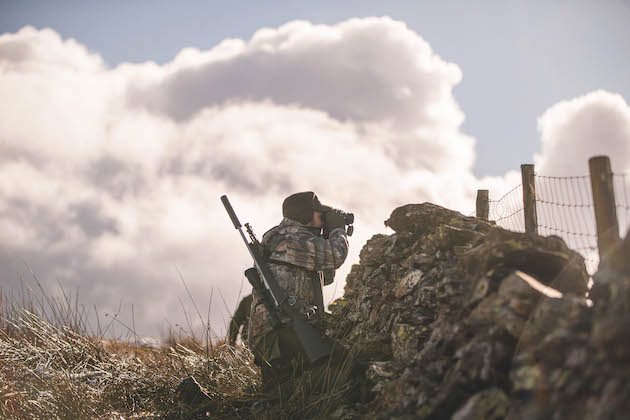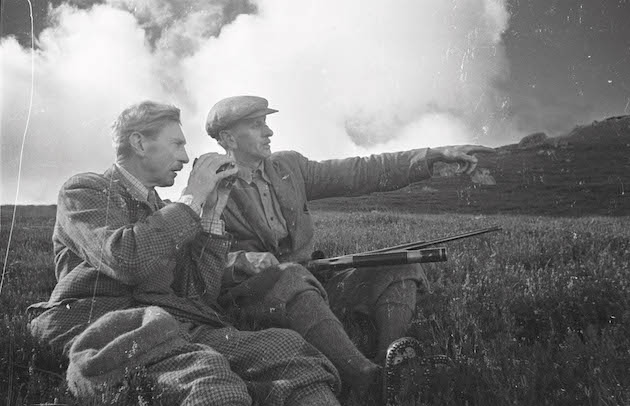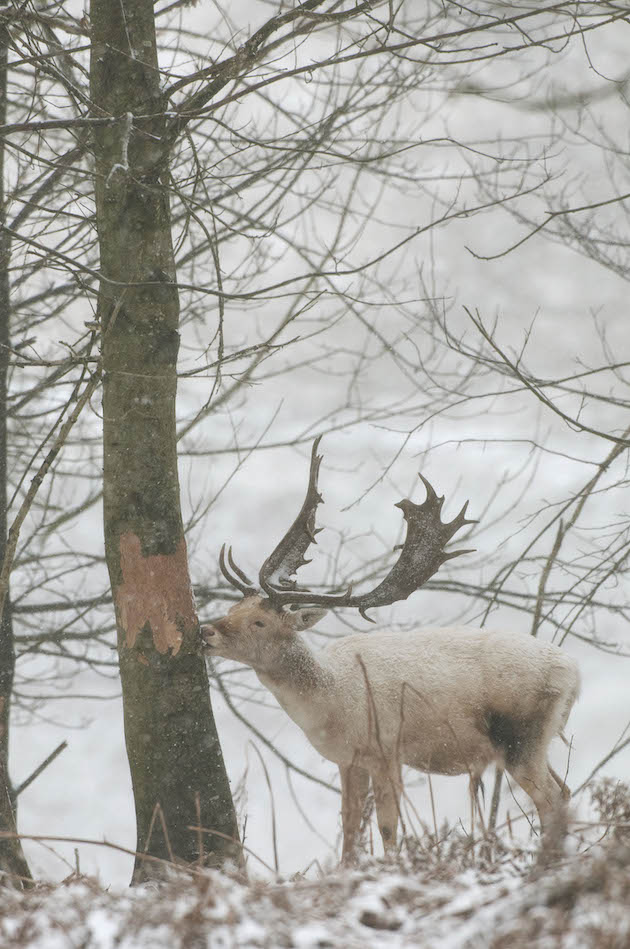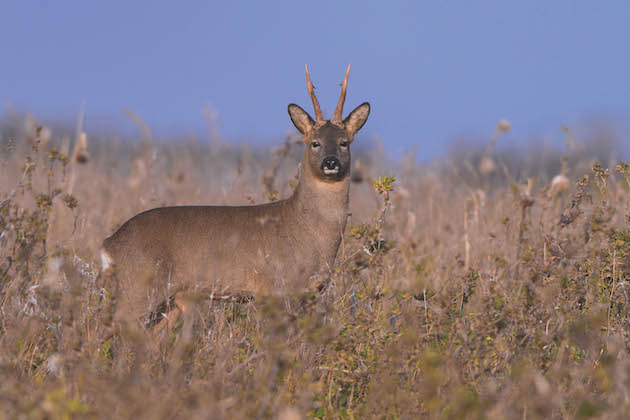Win CENS ProFlex DX5 earplugs worth £1,149 – enter here
Cull before the storm
 James pauses to check on the deer's position
James pauses to check on the deer's position
‘‘For at least 20 years, deer stalking has been one of the brightest stars in the shooting firmament. Its rise has tracked the steady growth in the range and population of our six native or naturalised deer species and has effectively resulted in the establishment of a new fieldsport.

Once centred on Highland Scotland, stalking very rapidly became a nationwide fieldsport
Until a few decades ago, mention of deerstalking essentially referred to one thing alone: the pursuit of red deer — particularly stags — in the Scottish Highlands.
In the lowlands of England, a few enthusiasts stalked roe, often drawing on the rich traditions of woodland stalking that had been imported from continental Europe, especially from Germany by returning ex-servicemen.
Fallow, too, were an important sporting quarry in some locations, especially in ancient hunting forests such as Epping or the New Forest, or in the context of large estates that had a long association with park deer. Low-ground stalking, however, was not exactly mainstream. But, then, several things occurred.
Changing policy
From the mid-1980s, the Government switched from support for intensive farming to agri-environment schemes that prompted the planting of thousands of acres of new woodlands and many miles of new hedgerows and conservation field margins.
At the same time, Forestry Commission policy moved away from single-species conifer plantations and towards broadleaved trees, with a focus on wildlife habitat.

Deer can cause damage to trees and need to be controlled to allow woodland to flourish
Rising deer numbers
The deer said “thank you very much”. With the countryside becoming more wooded and better connected by hedges, spinneys and cover crops, and given the natural fecundity of most deer species, deer numbers soared.
Roe continued their colonisation of central England, fallow spread throughout the localities of current and former deer parks, while ancient trees had red deer browsing beneath them for the first time in three centuries or more.
The numbers of muntjac, present in only a few isolated locations across the south Midlands and the east of England at the beginning of the 1970s, simply exploded. In the 30 years between 1972 and 2002, no other British species matched it in range expansion.
As measured by its presence in 10km grid squares, muntjac achieved an annual rate of increase of 8.2%, compared to 1.8% for fallow, 2.3% for roe and 2% for Chinese water deer. Suddenly, there were deer on the doorstep of most shooting enthusiasts across the southern half of England.
Landowners realised that rising deer numbers needed to be brought under control. Those who had undertaken planting schemes and were in receipt of government grants soon appreciated that unless damage was controlled, their farm incomes were in jeopardy.
Conservation bodies also woke up to the fact that browsing deer were putting unacceptable pressure on important wildlife sites. Soon, the management of deer received the seal of approval from the conservation establishment. More deerstalkers were needed.
Something else happened, too. The 1997 ban on target pistol shooting prompted many experienced firearm certificate holders to look at other branches of shooting sports. A significant number turned to rifles and, in particular, deerstalking.
Others came into stalking through the ‘hunting’ branches of shotgun shooting, such as rough shooting and wildfowling, and found that their love of fieldcraft and hunting skills transferred easily to a new and challenging quarry. Throughout the ‘noughties’, the British Deer Society experienced a surge in membership, and a 2007 survey of BDS members found that 32% had taken up stalking in the previous 10 years, while 16% had discovered the sport only in the previous five. Thousands enrolled on deerstalking certificate courses in order to learn more about deer and deerstalking.
Firearms figures
Home Office figures bear out the rise in the number of firearm certificates on issue in England and Wales. From 117,700 in 2002, the figure grew to 159,745 in 2019, and there are a further 26,000 certificate holders in Scotland. They are not all stalking-related, of course, but the National Firearms Licensing Management System across England and Wales shows that a little under 50,000 certificates are conditioned for shooting deer. This is a ‘best guess’ figure for the number of active deer stalkers, allowing for the fact that some shooters with .22 centrefires conditioned for pest control are also legitimately able to shoot muntjac and Chinese water deer. Some two-thirds of all deer stalkers have completed their DSC1 qualification.
However, in 2020, after 17 years of continual growth, the number of firearm certificates on issue dipped to 159,483. It is a small decrease in a statistic that is, as we have seen, no more than one-third stalking-related, but it is a decrease nonetheless.
Is it perhaps a signal that the growth has gone out of stalking? Has the bubble burst? “I’m not convinced that the number of stalkers is still on the increase,” says Martin Edwards, BASC’s head of deer management. “There’s not a significant change, but the number of stalkers is not growing.”

The traditions of woodland stalking in Europe led enthusiasts to stalk roe deer in lowland England
Age-old problem
He believes that it is now the older shooter who is looking to sidestep into deerstalking. “When we did a BASC survey of stalking members in 2006, the average age was 48, but when we did the same survey in 2020, it had risen to 55. We’ve got an ageing stalking population, that’s my concern. There are not as many youngsters coming in as I would like.”
Martin believes that there are now significant barriers to entry into deer stalking, especially by younger people. “A lot of people will do their DSC1 and then struggle to get hold of stalking opportunities. We get lots of inquiries from people who want to do DSC1 and often the prime reason is to find a stalking opportunity. “But it’s much harder now. Increasingly, landowners, and particularly institutional owners, require DSC2 and proof of practical competence. And in some areas it comes down to money.” These are holes that BASC is trying to plug with its stalking schemes, Martin adds. But his wider point about the ageing stalking population is valid. The average age of 55 identified by BASC matches that revealed by the latest BDS membership survey. Somehow, we must do more to encourage youngsters — a cry that I hear echoed across shooting sports in general.
There is a strong case for older stalkers mentoring younger ones and sharing with them the benefits of their years of experience. Some old hands are certainly concerned that younger, fitter and keener people may snatch away their stalking rights.
How true this is I cannot say, but what I do know is that a longstanding personal relationship between a time-served experienced stalker and a landowner counts for a great deal.
I can say from experience that the assistance of an additional young, strong pair of hands is most welcome when you’ve dropped a big fallow 150 yards into a wet ploughed field in late January. So let’s not worry too much about any risk that may or may not be attached to bringing in fresh blood.
Setting aside current difficulties over carcass sales, I do not believe that stalking is in crisis. The number of advertisements and product launches for new stalking kit tells its own story — remember that commercial manufacturers and distributors study and follow the market very closely.
Simon West, of the Gun Trade Association, believes there is still growth in stalking products and reports particular activity in thermal-imaging equipment.
Plans to plan millions of trees mean deer management will be more important than ever
Trading up
David Thompson, of Viking Arms, says that sales of stalking rifles are definitely on the increase, though he admits that some at least may be going to existing stalkers trading up to new products. That, of course, will always be true and some shooters will always be eager to move to the latest bit of kit, whether it be a straight-pull rifle to replace their conventional bolt action, or a 6.5 Creedmoor in preference to their old .243 Win.
But there is no doubt that, in the coming years, we will need more skilled and competent deerstalkers. Woodland creation is a key part of the Government’s 25-Year Environment Plan, which includes increasing the area of woodland in England to 12% of land by 2060. That means millions more trees and, without proper management of Britain’s burgeoning deer population, a good proportion of those are destined to disappear down cervine gullets.
Related Articles
Get the latest news delivered direct to your door
Subscribe to Shooting Times & Country
Discover the ultimate companion for field sports enthusiasts with Shooting Times & Country Magazine, the UK’s leading weekly publication that has been at the forefront of shooting culture since 1882. Subscribers gain access to expert tips, comprehensive gear reviews, seasonal advice and a vibrant community of like-minded shooters.
Save on shop price when you subscribe with weekly issues featuring in-depth articles on gundog training, exclusive member offers and access to the digital back issue library. A Shooting Times & Country subscription is more than a magazine, don’t just read about the countryside; immerse yourself in its most authoritative and engaging publication.







